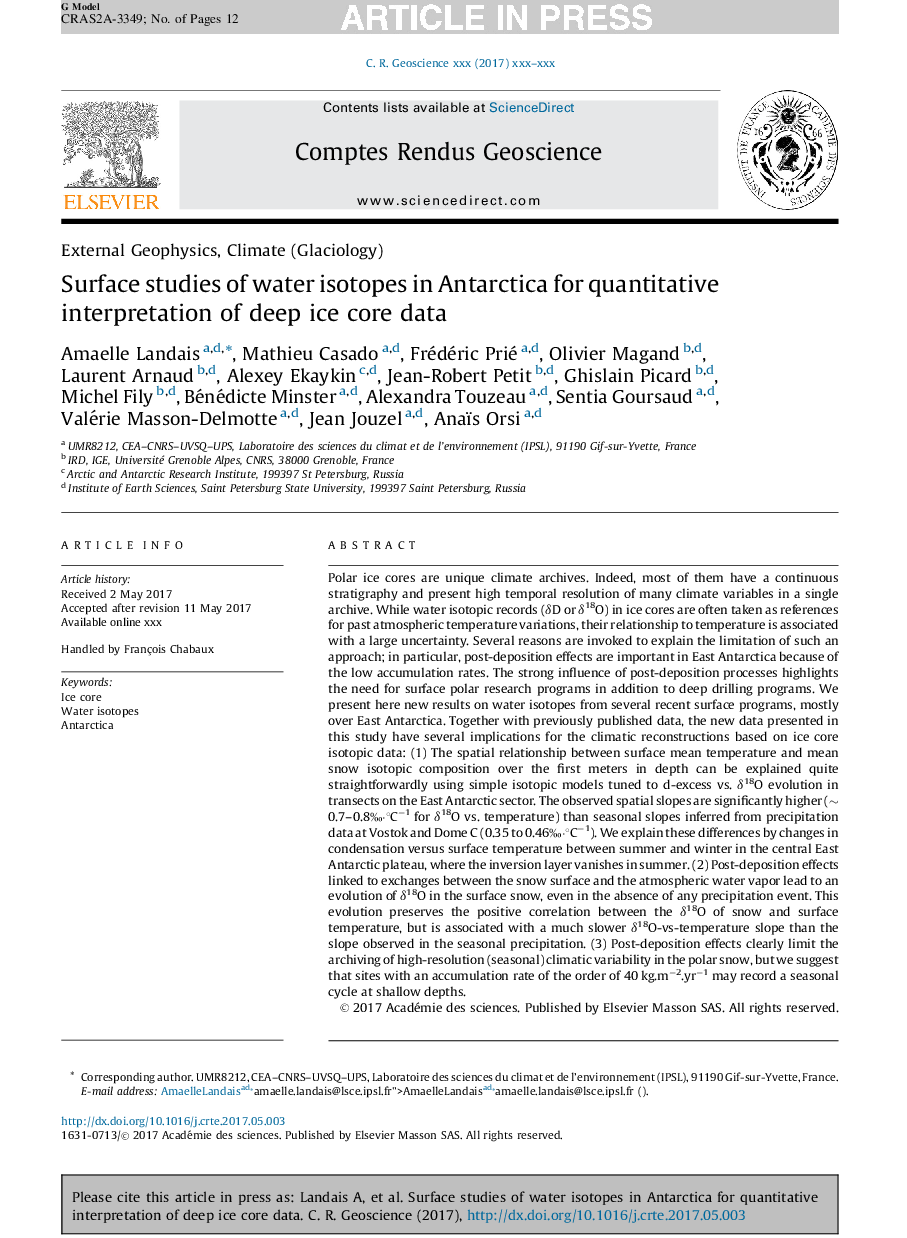| کد مقاله | کد نشریه | سال انتشار | مقاله انگلیسی | نسخه تمام متن |
|---|---|---|---|---|
| 5755186 | 1412651 | 2017 | 12 صفحه PDF | دانلود رایگان |
عنوان انگلیسی مقاله ISI
Surface studies of water isotopes in Antarctica for quantitative interpretation of deep ice core data
ترجمه فارسی عنوان
مطالعات سطحی ایزوتوپهای آب در قطب جنوب برای تفسیر کمی از داده های اصلی هسته یخی
دانلود مقاله + سفارش ترجمه
دانلود مقاله ISI انگلیسی
رایگان برای ایرانیان
کلمات کلیدی
هسته یخ ایزوتوپهای آب، قطب جنوب،
موضوعات مرتبط
مهندسی و علوم پایه
علوم زمین و سیارات
علوم زمین و سیاره ای (عمومی)
چکیده انگلیسی
Polar ice cores are unique climate archives. Indeed, most of them have a continuous stratigraphy and present high temporal resolution of many climate variables in a single archive. While water isotopic records (δD or δ18O) in ice cores are often taken as references for past atmospheric temperature variations, their relationship to temperature is associated with a large uncertainty. Several reasons are invoked to explain the limitation of such an approach; in particular, post-deposition effects are important in East Antarctica because of the low accumulation rates. The strong influence of post-deposition processes highlights the need for surface polar research programs in addition to deep drilling programs. We present here new results on water isotopes from several recent surface programs, mostly over East Antarctica. Together with previously published data, the new data presented in this study have several implications for the climatic reconstructions based on ice core isotopic data: (1) The spatial relationship between surface mean temperature and mean snow isotopic composition over the first meters in depth can be explained quite straightforwardly using simple isotopic models tuned to d-excess vs. δ18O evolution in transects on the East Antarctic sector. The observed spatial slopes are significantly higher (â¼ 0.7-0.8â°Â·Â°Câ1 for δ18O vs. temperature) than seasonal slopes inferred from precipitation data at Vostok and Dome C (0.35 to 0.46â°Â·Â°Câ1). We explain these differences by changes in condensation versus surface temperature between summer and winter in the central East Antarctic plateau, where the inversion layer vanishes in summer. (2) Post-deposition effects linked to exchanges between the snow surface and the atmospheric water vapor lead to an evolution of δ18O in the surface snow, even in the absence of any precipitation event. This evolution preserves the positive correlation between the δ18O of snow and surface temperature, but is associated with a much slower δ18O-vs-temperature slope than the slope observed in the seasonal precipitation. (3) Post-deposition effects clearly limit the archiving of high-resolution (seasonal) climatic variability in the polar snow, but we suggest that sites with an accumulation rate of the order of 40 kg.mâ2.yrâ1 may record a seasonal cycle at shallow depths.
ناشر
Database: Elsevier - ScienceDirect (ساینس دایرکت)
Journal: Comptes Rendus Geoscience - Volume 349, Issue 4, JulyâAugust 2017, Pages 139-150
Journal: Comptes Rendus Geoscience - Volume 349, Issue 4, JulyâAugust 2017, Pages 139-150
نویسندگان
Amaelle Landais, Mathieu Casado, Frédéric Prié, Olivier Magand, Laurent Arnaud, Alexey Ekaykin, Jean-Robert Petit, Ghislain Picard, Michel Fily, Bénédicte Minster, Alexandra Touzeau, Sentia Goursaud, Valérie Masson-Delmotte, Jean Jouzel,
